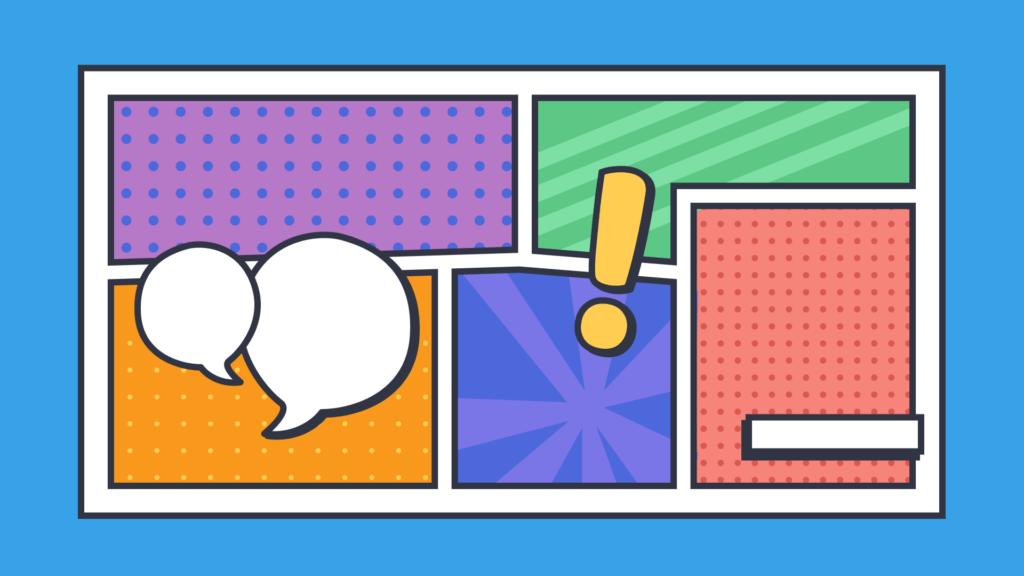Using storytelling as a teaching tool
In this guide
Using storytelling as a teaching tool
As a child I grew up in a 1 bedroom apartment with my parents and brother. My mom and dad both had jobs but they lived paycheck to paycheck.
There was a lot of love in my household but our days were also filled with the constant stress of not having enough money to feel truly secure.
As a child often your sense of time is warped, but it felt like half of my life was spent at the laundromat helping my mom with the laundry. I can still hear the jingle of the change machine spitting out those precious quarters needed to run each load.
Then, one day when I was at a friend’s house, I saw his mom doing laundry with their own machines in their own house. I was amazed how everyone could continue with their day while clothes were cleaned in the background.
When I went home I immediately proposed purchasing these magical home devices to my parents only to hear that we could not afford it. This life-changing laundry experience ignited something in me and I would not take no for an answer.
I sat down and started working on calculations for how long it would take to save up enough money for a washer and dryer if my parents stopped doing one thing: smoking. It was a win-win for me because the only thing I hated more than the laundromat was living in a permanent environment of smoke.
Within a day or two I had my numbers worked out and was ready to propose my revolutionary plan to my family…
The story I just told you is not my own. Instead, it is the story I heard from my 4th grade teacher when I was just nine years old. When I sat down to write this article, his words stood out as the perfect way to dive into this topic.
Admittedly, I added some details and flare using the storytelling techniques I have learned over the years but the general premise remains true to what I heard. I also have no memory of how his proposal went but I guess it was not a critical part of the story because clearly the point of the story still resonates with me today.
I am pretty sure the lesson that day was about arithmetic and equations but I think it is pretty safe to say that I would have no memory of those events today if it were not for the deeply personal and applicable story he shared with our class. So the real lesson was actually about a lot more than the specific content standards being covered that day.
Storytelling has been a powerful way to communicate throughout human history so it only makes sense that we include it in educational settings as well.
By integrating storytelling into the classroom, educators can create a dynamic and engaging learning environment that resonates with students on a deeper level.

The benefits of storytelling in education
Using storytelling as a teaching tool can increase engagement, develop creativity, and improve learning outcomes. Textbooks and pacing guides can strip the humanity and authenticity out of learning so incorporating stories can bring the information to life.
Some key advantages of integrating storytelling into your classroom include:
1) Improved retention
Studies show that character-driven stories with emotional content lead to a better understanding of important points as well as enhanced recall weeks later (Zak, 2014).
2) Develop empathy
Stories help us connect with other people and better understand their perspective (Hughes et al., n.d.).
3) Create interest
We are competing against powerful social media algorithms to grab and hold onto student attention. Stories can add an element of mystery, intrigue, or surprise to foster better engagement (C, 2004).
4) Provide relevance
A real world example or compelling story provides the context necessary for learners to buy into the process and find value in committing the resources needed to learn new information (Brady, 2023).
5) Student agency
Participating in and creating stories requires active involvement and decision making. Challenges are viewed as a natural part of the process and something that is meant to be overcome (The Value of Storytelling in Learning, 2020).

Activities and projects using storytelling
Leveraging creative classroom activities that incorporate storytelling techniques helps build a more dynamic learning environment. When students are exposed to different narratives and have the opportunity to develop their own, they feel more agency and purpose in their education.
The following ideas can easily be modified for a variety of subjects to get students thinking and creating:
1) Photo essay
I started using this project when I was teaching a digital photography class and it has inspired me to include more visual storytelling activities in my other courses. The goal here is storytelling so even if you do not have a background in photography, students will still benefit.
I allow students to pick any topic of their choice and then create 10 images to convey a story about that topic.
Possibilities include:
- A day in the life of a teenager,
- Living with a mental illness,
- The stress of school, or
- The beauty found in nature.
I ask students to complete this assignment without using any text in their images. I encourage them to think about what information and emotion each image is intended to evoke in their audience.
Have students go through review sessions with their peers to get feedback about their images and the order they are presented in order to create the best story possible.
A gallery walk or class presentations is a really fun way to conclude this project so students can see the work of their classmates and different visual storytelling techniques.
Stories without Words will provide students with some inspiration and support about how to visually express the ideas in their heads. It might also convince you to switch this activity from photography to drawing.
2) Story of a historical event
My U.S. History and Design program is rooted around storytelling. We look at American history through the lens of a startup business and analyze how different events have been portrayed throughout the years to either help or hurt the ‘business’ of America.
Starting the second week of class I assign each student to interview someone who was alive during the 9/11 attacks. Because my class is part of a digital media program I ask them to film the video, but this could work just as well as a more traditional written format.
Students start with the footage of their interview to determine the main story or theme of 9/11 from that person’s perspective. Then, they spend about a week finding archival footage to edit into their interview to help visually support the words from in their film.
We end up with a variety of amazing stories that help the class understand the power of different perspectives and give voice to the experiences of others.
You could easily adapt this structure to have students interview someone about their favorite childhood memory or an important scientific discovery. Ultimately, it is about gathering information and then creating a clear story viewers will connect with.
I highly recommend using The Art of Visual Storytelling series to help students take their work to the next level. They will be able to practice the techniques and skills the professionals use to create compelling digital media stories.
3) Graphic novel
I was largely unaware or ignorant of this genre until I had my own kids and it became their obsession. I quickly realized it was not unique to my children, so this became a great way to engage my students.
Just last week, I had a student submit a graphic novel about the founding of America rather than complete the same project as her classmates. Her love of art, drawing, and storytelling, helped compensate for her lack of enthusiasm in history.
My favorite example of this idea comes from one of my colleagues who asks his environmental studies classes to create graphic novels about recycling and sustainability. The class spends about a month creating, reviewing, and editing their work before sending them off to our feeder elementary school.
The students there read the stories and vote on their favorite one. The winning student gets to visit their class and read their original story to the class aloud and participate in a “Q & A with the author.”
Students get to practice valuable storytellings skills for a real audience about an important topic. (It is also really awesome to see how the high schoolers get more excited than the younger students!)
If you are like me and graphic novels or comics strips are outside of your expertise, then definitely check out Graphic Storytelling to get the background you need to get this project off the ground.
4) Movie analysis
For this activity, I use the opening scene from Pixar’s Up because it hits all of the points I am going for in less than 10 minutes, but, I bet your students would enjoy this activity more if you let them watch the whole movie!
After introducing the critical elements of a story (e.g. plot, characters, setting, tension, etc.) use a feature length film for students to find specific examples for each part of a story you would like them to learn about. My wife uses The Hero’s Journey as a framework for her elementary students.
Story Tools is also a wonderful series to reference to help specify the exact techniques or elements you want your class to be able to identify. The videos are aimed at written stories but can easily apply to movies as well. Or, modify this activity and have students complete it by reading a book of their choice.
The activity can be completed in notes or by using a worksheet, but I ask my students to create a short visual presentation to display their findings. They go online and find video clips or scenes they feel best represent the different elements of the story on which we are focusing.
The great thing about presentations is they lend themselves to a fun conclusion where students can share their work to further reinforce the learning concepts.

Leveraging technology for storytelling
The daily concerns about technology replacing human labor only seem to be intensifying. With a background in digital media and design I am constantly amazed by the improvement in visual tools and software that even novices have at their disposal.
With my students, I try to emphasize the aspects of storytelling that are still uniquely human so they can leverage existing technologies to bring their ideas to life. I think the following tools create a wonderful symbiosis between creativity and technology:
1) Image editing software
I use Adobe Photoshop in my class but there are a variety of free web-based options available too. I have students experiment with altering images to help enhance or change the story of a photograph.
In my history class, groups choose historical photos about the war they were assigned and then make changes or additions to help portray a common theme or story from that war. For instance, psychological trauma in WWI or distrust in government during the Vietnam War.
In the past, learning Photoshop was a major hurdle but, with updates in recent years, students can jump in and start creating some amazing stuff without a ton of teacher support. As a result, the focus is on intentional decisions that directly impact the experience of the viewers.
Students get valuable practice capturing someone’s attention and then conveying a powerful message through a variety of calculated techniques.
2) Digital storyboard
One thing I have noticed when teaching storytelling techniques is that students really struggle with organizing and ordering their ideas. They also often overlook the small details that are critical in clearing communicating messages.
Although many storyboard artists use hand drawn images, I found that to be a barrier for many of my students since they were not confident in their drawing skills. As a result, I ask students to create their storyboards digitally.
In addition to reducing the pressure on art skills, it also allows for easier rearranging of scenes if we discover a different order may be more effective. A tool like Google Slides can work but there are also a lot of online storyboard platforms designed specifically for this task.
Personally, I love the storyboard templates available in Canva because they provide different levels of structure and there are a ton of easy to use design assets to bring their ideas to life.
Let students watch How to Create a Storyboard before they start. It does a great job explaining the mindset and approach to take when starting to build out the different components of a story.
3) TED Talks
Short form videos with powerful stories is what keeps people scrolling on their phones way longer than they intended. Taking advantage of this situation rather than simply dismissing it offers an opportunity to learn, reflect, and create.
While social media examples could work for this scenario, I prefer to use TED Talks in my class because students can see the way presenters artfully weave research and insights into a beautifully engaging story.
As an added benefit, I can use topics that are relevant to what I want students to be exposed to – so it serves as a dual benefit. We watch these videos as a class and then discuss the techniques used to captivate and connect with the audience.
Even if students do not enjoy the video, they can provide a critique of what was missing or should have been changed to create more engagement.
I love to ask students to go online and find additional TED Talks they feel do a great job entertaining and inspiring the viewers. Before you know it, they have done some research and learned about a topic on their own while adding to their storytelling toolkit!
Addressing challenges in storytelling
When students struggle with storytelling I reference the process stand-up comedians use to create their routines. They will spend months practicing and refining variations of a joke to determine exactly what works. Each of these jokes is a small story that took nurturing and revisions to reach maximum impact.
We as educators need to understand the same thing is true for us as we develop as storytellers. It is a learned skill but it is also one that applies to so many facets of life that it is definitely worth the investment. If you or your students need some motivation to stick with it then definitely check out Creative Process.
One other issue to consider when using storytelling as a teaching tool is one we are all too familiar with in education… time. It feels like it is yet another thing to teach and something that takes students much longer than traditional assessments.
Humanity’s shared history around storytelling should be our first clue supporting why this is definitely time worth investing. The benefits of incorporating storytelling in education demonstrate the same results humans experienced when learning well before traditional education was ever established.
Storytelling is not effective because it is quick and easy. It is effective because our minds crave stories and all of the tension or challenges that help make them so interesting.
Conclusion
Over 30 years have passed since I was sitting in that 4th grade class, but I can still see the imagery that was going through my mind while my teacher wove this powerful story of math, health, finance, and problem solving from his personal experience.
I cannot remember the exact lesson, or the equations we were covering that day but the lasting impact was much more important than the specific content. The story resonated with me and created an anchor point in my memory to give value to the material we were learning about in class.
I am proud to say that I do not smoke cigarettes and I am incredibly organized when it comes to budgeting and spending. I am confident in my math skills, but I am more thankful for the other habits that this story helped me develop.
Stories connect us and activate parts of the brain that are critical to long term memory. Stories should not be limited to movie theaters or the books we read after a long day of work.
Using stories in your class will add life to the content. Helping students become better storytellers will provide them with transferable skills that they can use to their advantage throughout the rest of their lives.
References
- Brady, J. (2023, January 31). The Educational Benefits of Storytelling. University Center for Teaching and Learning. https://teaching.pitt.edu/resources/the-educational-benefits-of-storytelling/
- C, M. (2004, April 1). Storytelling in Teaching – Association for Psychological Science – APS. Association for Psychological Science. Retrieved January 27, 2025, from https://www.psychologicalscience.org/observer/storytelling-in-teaching
- Hughes, J., Oliveira, J., Bickford, C., & Southern New Hampshire University. (n.d.). The Power of Storytelling to Facilitate Human Connection and Learning | IMPACT. Boston University. Retrieved January 27, 2025, from https://sites.bu.edu/impact/previous-issues/impact-summer-2022/the-power-of-storytelling/
- The value of storytelling in learning. (2020, June). Wharton Interactive. https://interactive.wharton.upenn.edu/learning-insights/value-storytelling-learning/
- Zak, P. J. (2014, October 28). Why Your Brain Loves Good Storytelling. Harvard Business Review. Retrieved January 27, 2025, from https://hbr.org/2014/10/why-your-brain-loves-good-storytelling

Nick Schwab
briefcase iconLearning Experience Designer
Nick combines his background in psychology, education and design to create physical and digital experiences that empower, engage, and excite learners. His passion lies in constantly developing new learning pathways for students that challenge the status quo in education.
Other posts
Want more content like this?
Subscribe for blog updates, monthly video releases, trending topics, and exclusive content delivered straight to your inbox.




















